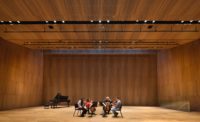New York City, New York
Cooper-Hewitt, National Design Museum
Although the Cooper-Hewitt exhibition “Provoking Magic: Lighting of Ingo Maurer” represents less than one-third of the German designer’s oeuvre, the show’s 53 pieces reveal the staggering breadth of Maurer’s imagination. Feathers, broken china, goldfish, gilded cages—nothing is off limits as raw material for a luminaire. As the first solo exhibition of Maurer’s work in the United States, visitors to “Provoking Magic,” who may only know Maurer for his Baccarat crystal–encrusted Unicef Snowflake, certainly will be impressed by how tirelessly he has devoted his fertile mind to lighting design.
Maurer hadn’t intended to enter the profession, first apprenticing himself to a typographer and then studying graphic design. But in 1965, staying in a pensione in Venice, he became smitten by the single light bulb hanging over his head. The following year he introduced a prototype of Bulb at the Milan Furniture Fair. This tungsten light bulb housed within a larger glass caricature—a transparent Jonah and whale—attracted the interest of modern design’s biggest manufacturers, and Maurer decided to produce it himself. So began his four-decade-and-counting career as both designer and manufacturer.
It also initiated a string of paeans to the bare bulb, including the popular Lucellino. A flock of these delightfully winged bulbs greets visitors to “Provoking Magic” as they climb the Carnegie Mansion stairs to the exhibition’s second-story perch. The mansion’s stairwell chandelier has been smothered in red stocking fabric and myriad Lucellinos are mounted from the wrapper, appearing to perform a kind of avian choreography around it.
This setting also includes the first of a series of interventions that Maurer conjured specifically for “Provoking Magic.” The designer rigged moving mouths and eyes to portraits of Andrew and Louise Carnegie, which look at the chandelier swathed in red. The prank also includes a soundtrack: On loop, the two ghosts converse about the changes Maurer has made to their home. Andrew complains that Maurer’s lights are too modern for his taste, and the whisper repeats itself until you’ve reached a far gallery outside of earshot.
What makes Maurer’s work so modern? The question tugs at you almost as naggingly as the audio clip. Indeed, these luminaires and installations seem particularly resonant as well as accessible within the historic fabric of the Carnegie Mansion: One visitor even pleaded with a museum guard to get a closer look of the grand chandelier called Luxury Pure; the guard acquiesced, and she walked underneath and around the three-layer pendant, wondering aloud whether or not Luxury Pure would suit her New York apartment. There is also the matter of historical context. The Carnegie Mansion was once considered the height of modern technology (completed in 1902, its steel frame, Otis elevator, and climate-control systems were practically unprecedented). For a designer who fetes bare light bulbs—not terribly different from the form they first took in Edison’s hands—several of Maurer’s works could be considered no more modern than electrification itself.
The answer lies in Maurer’s treatment of his subject, and his graffiti-punctuated Carnegie portraits epitomize his approach. Simply put, the designer is a master of the double-take. In another love letter to the plain light bulb, the cartoon-like room installation Wo bist du, Edison…? features a smashed bulb on a table and a hologram of another hovering above it—the idea versus the reality. Meanwhile, a simple projector pointed on the mirrored water basin Tableaux Chinois creates a shimmering dance of light and shadow, thanks to the wake left by goldfish navigating floating mirrors.
Just as Maurer’s obsession with light applies equally to the lighting object and lighting effects, “Provoking Magic” also presents museumgoers with the designer’s experiments with illumination technology. YaHaHo, a low-voltage halogen lamp that almost bankrupted Maurer, is now a ubiquitous fixture in the marketplace. Meanwhile, other efforts have yielded new double-takes. Maurer’s LED Bench powers myriad pinpoints wirelessly, for example, and in a fitting act of trompe l’oeil, the installation Rose, Rose on the Wall features a televised fireplace. The future of lighting has little to do with gas flames and filaments, these delightful pieces suggest, and if Andrew Carnegie were alive to contemplate that charge toward innovation, he would surely approve of Maurer after all.















Post a comment to this article
Report Abusive Comment